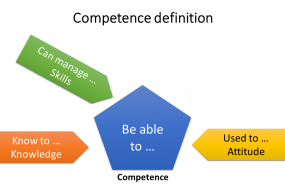VTT-Box and Competences
This page offers several tools in context with competences, competence definition, and the competences for the self-evaluation mandala.
The toolbox is based on competency based learning (and teaching) as it is common in the European Community (EC). Competences are defining something that the learner should be able to do finally. These competences consist of knowledge, skills, and attitudes.
The tool assists in the creation of the competence which is the central learning aim of the course. This competence is also needed to create the self-evaluation mandala(s).
What is a competence?
A competence (or competency)[1] is the combination of observable and measurable knowledge, skills, abilities and personal attributes that contribute to enhanced learner’s performance and ultimately result in organizational success. To understand competencies, it is important to define the various components of competencies.
How to define a competence?
Here is a description of the approach step by step
- Define a competency using a sentence starting with “The learners are able to …” and now describe what you expect the learners can do after the learning (in a short sentence).
- The competency (typically defined in the European Community) consists of three items and is defined by terms of knowledge, skills, and attitude (of behavior).
- Knowledge can be described by the keywords “know”, “describe”, “explain”, “appoint” and similar terms
- Skills can be described by terms like “use”, “apply”, “administer”, “implement” or similar expressions
- Attitudes can be described by terms like “evaluate”, “justify”, “recommend” and similar terms
- Using these terms, you will find sentences describing the components of the competence.
Now you may use one of the Self-evaluation Mandala tools to create the Mandala. Here is an example (subject: information technology)
| Item | Description |
|---|---|
| Competency | Learners are able to work with local area networks |
| Knowledge | Learners know the general structure of a network and can describe the various components and functionality |
| Skills | Learners can implement a simple network and can administer this. |
| Attitude | Learners can evaluate the technical aspects of a network> |
This example is also used to explain the creation of the Self-evaluation Mandala
To assist you in the creation of a visualisized competence scheme we created the “Competence Creation Tool”. It is word-processing based and is available for two different software products.
- Competence Creation Tool [WORD Download]
- Competence Creation Tool [Open Office Download]
Context between competence and self-evaluation mandala
Here you may watch the animation showing the competence definition and the context to the self-evaluation mandala.
____________________
[1] What is the difference between competence and competency?
Competence describes a person’s capability to do something adequately, or a person’s mental capacity Competency is an alternate noun form of competent, which is an adjective. In effect, competence and competency are interchangeable, though competence is more often used to describe a person’s general ability, while competency is more often used to describe a person’s ability to perform a certain task. to understand the proceedings of a trial. Competence is the noun form of competent, which is an adjective.
Source: grammarist.com/words/competence-and-competency/
